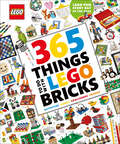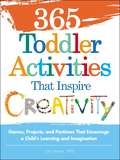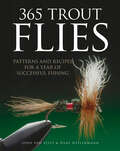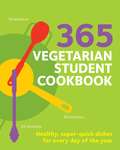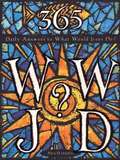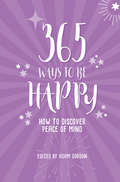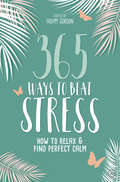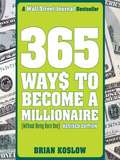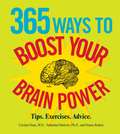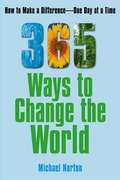- Table View
- List View
365 Things to Do with LEGO Bricks (Library Edition): Lego Fun Every Day of the Year
by Simon HugoHundreds of creative LEGO® build ideas, activities, games, challenges, and pranks! Winner of the Best Book category Creative Play Awards 2016, this superb LEGO build book inspires you to look at your LEGO bricks in new and exciting ways. Go on a LEGO treasure hunt. Create and perform LEGO magic tricks. Make a LEGO stop-motion movie. Build your own LEGO pet. Challenge your family to build the tallest LEGO tower—and much, much more! Featuring imaginative play and building ideas—from LEGO games that take just a few minutes and require a handful of bricks, to inspirational build ideas and activities to keep you occupied for hours.©2020 The LEGO Group. All rights reserved.
365 Toddler ActivitiesThat Inspire Creativity
by Joni LevineActivities for imaginative playtime - every day of the year! With 365 Toddler Activities That Inspire Creativity, you can spark your child's creativity and maximize his or her potential every day of the year. Written by an experienced child-care expert, you will find hundreds of entertaining toddler activities, songs, games, and art projects that stimulate cognitive development and encourage inventiveness. You and your toddler will enjoy playtime with age-appropriate activities like: Magic Sun Prints Treasure Chest Sprout in a Bag Rainbow Toast Fishing in the Tub All-About-Me Book And so many more! Featuring everything from outdoor activities to rainy-day fun, 365 Toddler Activities That Inspire Creativity provides hours of creative toddler play!
365 Toddler ActivitiesThat Inspire Creativity
by Joni LevineActivities for imaginative playtime - every day of the year! With 365 Toddler Activities That Inspire Creativity, you can spark your child's creativity and maximize his or her potential every day of the year. Written by an experienced child-care expert, you will find hundreds of entertaining toddler activities, songs, games, and art projects that stimulate cognitive development and encourage inventiveness. You and your toddler will enjoy playtime with age-appropriate activities like: Magic Sun Prints Treasure Chest Sprout in a Bag Rainbow Toast Fishing in the Tub All-About-Me Book And so many more! Featuring everything from outdoor activities to rainy-day fun, 365 Toddler Activities That Inspire Creativity provides hours of creative toddler play!
365 Toddler ActivitiesThat Inspire Creativity: Games, Projects, and Pastimes That Encourage a Child's Learning and Imagination
by Joni LevineActivities for imaginative playtime - every day of the year!With 365 Toddler Activities That Inspire Creativity, you can spark your child's creativity and maximize his or her potential every day of the year. Written by an experienced child-care expert, you will find hundreds of entertaining toddler activities, songs, games, and art projects that stimulate cognitive development and encourage inventiveness. You and your toddler will enjoy playtime with age-appropriate activities like:Magic Sun PrintsTreasure ChestSprout in a BagRainbow ToastFishing in the TubAll-About-Me BookAnd so many more! Featuring everything from outdoor activities to rainy-day fun, 365 Toddler Activities That Inspire Creativity provides hours of creative toddler play!
365 Trout Flies: Patterns and Recipes for a Year of Successful Fishing
by John van Vliet Hans WeilenmannThe average fly fisher spends just 15.6 days per year on the water. Of course, few of us are fortunate enough to spend every day of every month casting into riffles, pools, and undercut banks in search of those finicky browns, brooks, rainbows, and cutthroats. Luckily, the diverse collection of gear in 365 Trout Flies provides some measure of solace to those legions of desk-bound fly fishers. Presenting enough flies to span the year, expert fly fisherman John van Vliet offers suggestions for the spectrum of salmonids fly fishers are most likely to encounter as well as the breadth of locations—from small, pastoral chalk streams to forested, free-stone rivers. Each spread depicts a group of three flies along with materials recipes, captions from the author detailing how and where to fish them, and interesting related historical facts. For ease of reference, the book is organized into five categories covering each of the major fly types—nymphs, dries, wets, streamers, and terrestrials—and is illustrated throughout with exclusive macrophotography of the flies themselves. The front matter and section openers are illustrated with gorgeous, scenic fly-fishing photos. From traditional stalwarts like the Adams, Light Cahill, Royal Wulff, and Hare’s Ear Nymph to more modern twists like synthetic inchworms, sand-encased caddis emergers, and the Chernobyl ant, John van Vliet’s 365 Trout Flies functions as both a practical how-to guide for the fly enthusiast and a handsome collection highlighting the art of these faux-entomological wonders.
365 Vegan Smoothies
by Kathy PatalskyFrom one of America's most vocal health-food advocates: a bounty of delicious, healthy vegan smoothies that deliver fun, flavorful wellness every day of the year With 100,000 Twitter followers and a blog that receives half a million unique visitors a month, food writer Kathy Patalsky loves sharing her passion for healthy, vegan cuisine. With 365 Vegan Smoothies, she makes it possible for everyone to enjoy this daily diet enhancement that is free of animal products (even honey) and the saturated fats, chemicals, and hormones that often accompany them. From her frosty sweet "Peach Pick-Me-Up" to green smoothies such as her revitalizing "Green with Energy," Patalsky's innovative smoothie recipes are built around themes such as brain boosters, weight loss, healthy digestion, and detoxification. She also includes mood tamers, such as the "Cheerful Chocolate Chia," with B-complex vitamins and omega fatty acids to boost serotonin levels. Featuring vibrant color photographs and simple steps to stock a healthier pantry, 365 Vegan Smoothies serves up the perfect blend for everyone.
365 Vegetarian Student Cookbook
by Sunil VijayakarThis flexible cookbook allows you to choose from a range of tempting recipes based on how much time you have available. Inside, you will find 365 dishes that will inspire and motivate students to get cooking every day of the year. This fantastically flexible approach will help you create a variety of great dishes including breakfast and light bites, midweek meals, family favourites, food for friends and delicious desserts.
365 Vegetarian Student Cookbook (Hamlyn Quick Cooks)
by Sunil VijayakarThis flexible cookbook allows you to choose from a range of tempting recipes based on how much time you have available. Inside, you will find 365 dishes that will inspire and motivate students to get cooking every day of the year. This fantastically flexible approach will help you create a variety of great dishes including breakfast and light bites, midweek meals, family favourites, food for friends and delicious desserts.
365 WWJD
by Nick HarrisonWhat Would Jesus Do? Ask the questions and live the answers, every day of the year This one-of-a-kind collection of devotional readings will help you nourish and deepen your faith through the simple yet powerful daily practice of answering the question, "What would Jesus do?" A jewel of wisdom for every day of the year, each entry is drawn from Scripture with practical reflections on how we can live the WWJD? life as well as inspiring words from notable Christian writers, such as Dietrich Bonhoeffer, Richard J. Foster, Charles H. Spurgeon, Billy Graham, Elisabeth Elliott, Martin Luther King Jr.,C.S. Lewis, Eugene Peterson, and many others. Here, author Nick Harrison invites us to accept this same challenge. It is "a pledge that the Apostle John says is a surefire test of our Christian faith....One year from now, may our lives be richer for having taken the time to learn the lessons gained by answering 'What would Jesus do?'" 365 WWJD? offers people of all ages daily food for thought, warmly reminding us of the many ways we can model our everyday actions after the life of Jesus.
365 Ways To Kiss Your Love: A Daily Guide To Creative Kissing
by Tomima L. EdmarkThe days of true romance and passion are back. Kissing your love no longer need be a routine event bordering on the tedious. Put some fire back into your romance with a different kind of kiss for every day of the year. Whatever the mood or the time, there is a kiss to fit the moment. With 365 Ways To Kiss Your Love: A Daily Guide To Creative Kissing, author Tomima Edmark shows how you and your love can continually discover new pucker power. Edmark delivers 365 unique kisses destined for the lips of your love. The kisses are romantic, hilarious, tender, corny, tasty and, yes, even outrageous. This book takes you from the start of the year to the end, offering fun-loving kissing techniques that turn otherwise mundane settings such as toll booths and high-rise elevators into romantic hot spots. Do you know the correct technique for initiating a Resuscitation Kiss? Do you want to know what goes into a successful "Eureka Kiss"? For the history buff, there are kisses related to 19th Century Scottish weddings, Medieval Indians and the Greeks' preparation of thyme as a love herb. There is the Morse Code kiss... the Ping Pong kiss... kisses involving sleeping bags, fire extinguishers (which often come in handy throughout this book) and confetti. If movies are your thing, take your cues from Tracy and Hepburn, or the Catwoman. Put romance back in your and your love's life. From one day to the next, kissing will never be the same!
365 Ways to Be Confident: Inspiration and Motivation for Every Day
by Summersdale PublishersDo you want to be a bolder, more self-assured you? Tap into your inner confidence every day with this inspirational collection of self-care ideas, practical tips, motivating activities and mood-boosting statements. Spark your self-confidence with this little book of positivity.
365 Ways to Be Confident: Inspiration and Motivation for Every Day
by Summersdale PublishersDo you want to be a bolder, more self-assured you? Tap into your inner confidence every day with this inspirational collection of self-care ideas, practical tips, motivating activities and mood-boosting statements. Spark your self-confidence with this little book of positivity.
365 Ways to Be Fitter: Inspiration and Motivation for Every Day
by Summersdale PublishersDo you want to be a fitter, healthier you? Stay motivated every day with this handy collection of workout ideas, top training tips, invigorating activities, healthy eating suggestions and words of wisdom. From nutrition to stamina, this little book will help get you into great shape.
365 Ways to Be Happy: How to Discover Peace of Mind
by Adam GordonA unique collection of insightful tips and techniques ideally suited to reduce stress and point the way to inner peace. Whatever your situation, interest or mood or there'll be something here that will lift your spirits above the everyday and ease you towards a more fulfilling life.A miniature treasure trove of wisdom and insight, 365 Ways to Be Happy has everything you need as you embark on your road to enlightenment. A soothing blend of insights, affirmations and practical techniques, this is the perfect book to help your mind unwind from the hustle and bustle of daily life and to embark on a spiritual journey to new A miniature treasure trove of wisdom and insight, 365 Ways to Be Happy has everything you need as you embark on your road to enlightenment. A soothing blend of insights, affirmations and practical techniques, this is the perfect book to help your mind unwind from the hustle and bustle of daily life and to embark on a spiritual journey to new inspiring horizons. Packed full of illustrations, 365 Ways to Be Happy offers an around-the-clock supply of peace of mind. Life today is a swirl of stress, distraction and nonstop physical, mental and emotional exertion all set to the frantic, heart-pounding pace of the modern world. That's why this book is such an indispensable companion. Neatly organized into universal themes that have perplexed and inspired humankind for centuries, readers can thumb their way through passage after profound passage on love, health, happiness, parenting and just about everything else under the sun.
365 Ways to Be Happy: Inspiration and Motivation for Every Day
by Summersdale PublishersDo you want to be a joyful, more positive you? Tap into your inner optimist every day with this uplifting collection of motivating tips, mood-boosting activities, wise words and affirmations. From moments of delight to long-term emotional well-being, this book will help you find your happiness.
365 Ways to Be Happy: Inspiration and Motivation for Every Day
by Summersdale PublishersDo you want to be a joyful, more positive you? Tap into your inner optimist every day with this uplifting collection of motivating tips, mood-boosting activities, wise words and affirmations. From moments of delight to long-term emotional well-being, this book will help you find your happiness.
365 Ways to Be Inspired: Inspiration and Motivation for Every Day
by Summersdale PublishersDo you want to be an inspired, more innovative you? Tap into your creativity every day with this motivating collection of imaginative and crafty ideas, top tips, invigorating activities and wise words. Light up your mind with this little book of inspiration.
365 Ways to Be Slimmer: Inspiration and Motivation for Every Day
by Summersdale PublishersDo you want to be a leaner, healthier you? Get started and stay motivated every day with this handy guide. With meal suggestions, fitness ideas and tips to help you create healthy habits for the long-term, this little book will steer you towards getting into great shape and feeling good.
365 Ways to Beat Stress: How to Relax & Find Perfect Calm
by Adam GordonNo other book offers so many easy-to-use and diverse stress-relief techniques in a uniquely attractive gift package.With a different technique or tip for each day of the year, no other book offers such a wide range of ways to release stress and anxiety, all set in an attractive illustrated design that will make dipping in for inspiration a joy. All the practices are effective yet also easy to follow, even if you have never tried them before, and range from energy techniques such as simple shiatsu, to quick stress fixes such as visualizing a blue bubble, to methods of life simplification such as avoiding a news overload and rationing your evenings out, to inspiring visualizations such as imagining yourself as the sky or as a lotus floating on water. This is one of the first two publications in a new 365 series from Watkins, showcasing easy, accessible and effective approaches to dealing with our demanding modern lives. Readers are free to work through the book in any order they like, either using the chapter headings to deal with aspects that they feel need particular attention (for example, home, work, relationships, mind and spirit, or stress and emotions), flicking through at random or selecting ideas in chronological order. There is no need to subscribe to any particular belief, lifestyle or long-term practice; this is simply a collection of brilliantly effective ideas that together have the potential to transform lives.
365 Ways to Become a Millionaire
by Brian KoslowA self-made millionaire shares the secrets of his success in this updated and repackaged classic Brian Koslow made his first million dollars by the time he was thirty-one, and as an executive coach he’s helped others do the same. In 365 Ways to Become a Millionaire, Koslow shares the principles that put him on the road to wealth and invites readers to follow the same path to their own fortunes. Through 365 practical and philosophical tips, Koslow shows people how to build a mind-set for success and turn their wealth-building aspirations into reality. For anyone ready to stop dreaming about wealth and start building it, 365 Ways to Become a Millionaire will show them the way. .
365 Ways to Boost Your Brain Power
by Carolyn Dean Valentine Dmitriev Donna RaskinAn apple a day doesn't just keep the doctor away, it can also improve memory. From eating the right foods to knowing the right exercises, becoming smarter isn't always about textbooks and tests. With this practical, interactive guide, you can amp up your IQ in no time! Filled with 365 tips and tricks to better the brain, you'll learn that: Gingko Biloba increases blood flow to the brain learning a new language improves brain function classical music will help your problem-solving abilities sitting up straight doesn't just elevate your body, it improves your thinking process taking a brisk walk builds a better connection between brain cells eating at least one cup of blueberries a day reduces the effects of Alzheimer's disease or dementia and other brain boosting facts! This book is all that's needed for smarter living#151;starting now.
365 Ways to Boost Your Brain Power
by Carolyn Dean Valentine DmitrievAn apple a day doesn't just keep the doctor away, it can also improve memory. From eating the right foods to knowing the right exercises, becoming smarter isn't always about textbooks and tests. With this practical, interactive guide, you can amp up your IQ in no time! Filled with 365 tips and tricks to better the brain, you'll learn that: Gingko Biloba increases blood flow to the brain; learning a new language improves brain function; classical music will help your problem-solving abilities; sitting up straight doesn't just elevate your body, it improves your thinking process; taking a brisk walk builds a better connection between brain cells; eating at least one cup of blueberries a day reduces the effects of Alzheimer's disease or dementia; and other brain boosting facts! This book is all that's needed for smarter living - starting now.
365 Ways to Boost Your Brain Power: Tips, Exercise, Advice
by Carolyn DeanAn apple a day doesn't just keep the doctor away, it can also improve memory. From eating the right foods to knowing the right exercises, becoming smarter isn't always about textbooks and tests. With this practical, interactive guide, you can amp up your IQ in no time! Filled with 365 tips and tricks to better the brain, you'll learn that:Gingko Biloba increases blood flow to the brainlearning a new language improves brain functionclassical music will help your problem-solving abilitiessitting up straight doesn't just elevate your body, it improves your thinking processtaking a brisk walk builds a better connection between brain cellseating at least one cup of blueberries a day reduces the effects of Alzheimer's disease or dementiaand other brain boosting facts! This book is all that's needed for smarter living-starting now.
365 Ways to Boost Your Metabolism: Everyday Tips to Achieve Your Maximum Fat-Burning Potential
by Rachel LaferriereOkay, so you probably weren't born with the metabolism of a Nicole Kidman or Johnny Depp. That doesn't mean you have to surrender to a slow metabolism forever. You can increase your metabolic rate-and tone up and trim down!-no matter what your age or fitness level. With this practical handbook, you will set your metabolism afire when you incorporate these 365 easy, surefire tips into your daily lifestyle, including: Jump rope five minutes a day, Have a pomegranate for lunch, Replace your three squares a day with grazing, Drink green tea, Eat every two hours, Develop a taste for chili peppers, Weight train three times a week, Sprinkle cayenne pepper on every entree, Have your thyroid checked, Build interval training into your workouts, Swap 20 percent of your daily carbs for lean protein, Eat a minimum of 1,200 calories per day, Take the stairs, Add 2 teaspoons of cinnamon a day to your diet (or try capsules) You are not what you eat, you are what you burn when you eat!
365 Ways to Change the World: How to Make a Difference... One Day at a Time
by Michael NortonYou want to make a difference in the world, but don't know where to begin. Now you can. Here is just the guide to lots of exciting ways that are more personal and fun than merely writing a check. For every day of the year, 365 Ways to Change the World is packed with information and ideas that don't take a lot of special skills to put into action, but will achieve something positive: Observe a "Buy Nothing Day" Plant a "peace pole" Sew a panel for an AIDS memorial quilt Collect rainwater to water your plants The suggestions cover twelve important areas in which you can influence change, including in your local community, as a consumer, making a cultural contribution, and addressing problems such as the environment, health, and human rights. You can go through the book day by day or use the index to flip to the issues that concern you most; to help you take action, a complementary website links straight to many of the sources listed in the book. Great to give as well as to keep, this is an inspiring, practical resource for making the world a better place -- one day at a time.
